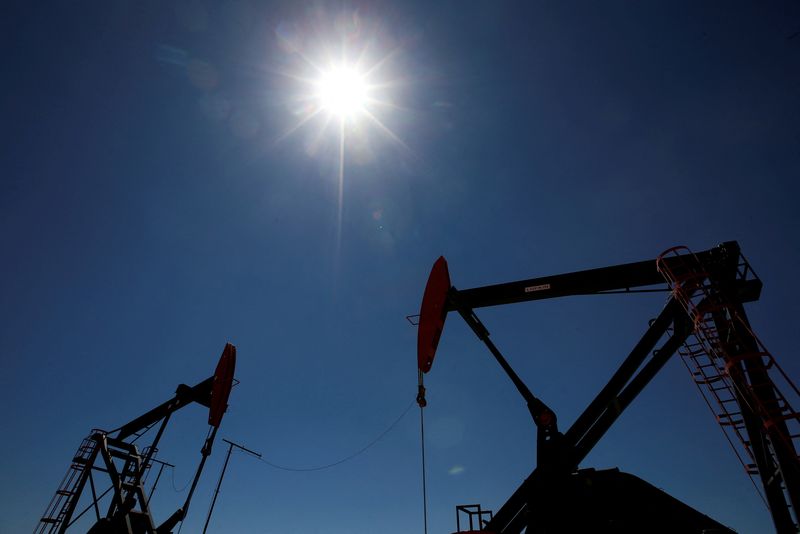Commodities
Oil prices rise, but post biggest weekly decline since March


© Reuters. FILE PHOTO: Oil rigs are seen at Vaca Muerta shale oil and gas drilling, in the Patagonian province of Neuquen, Argentina January 21, 2019. REUTERS/Agustin Marcarian/File Photo
By Stephanie Kelly
NEW YORK (Reuters) -Oil prices rose on Friday but remained posted their steepest weekly losses since March, after another partial lifting of Russia’s fuel export ban compounded demand fears due to macroeconomic headwinds.
On Friday, futures settled up 51 cents at $84.58 per barrel. U.S. West Texas Intermediate crude futures settled up 48 cents at $82.79.
For the week, Brent posted a decline of about 11% and WTI recorded an over 8% drop, on worries that persistently high interest rates will slow global growth and hammer fuel demand, even if supplies are depressed by Saudi Arabia and Russia, who said they will continue supply cuts to year end.
U.S. job growth rose by 336,000 in September according to Labor Department statistics, far exceeding economists’ forecasts of a 170,000 rise.
The sentiment of the statistics is mixed for oil prices. A robust U.S. economy could buoy sentiment for near-term oil demand, analysts said, but conversely the statistics resulted in a stronger U.S. dollar and increased bets on another interest rate hike in 2023.
A strong U.S. dollar is typically negative for oil demand, making the commodity relatively more expensive for holders of other currencies.
“Today’s (jobs) number keeps alive the prospect of another rate hike and certainly backs the Federal Reserve’s argument on the need for interest rates to stay higher for longer,” ING analysts said in a note.
Russia announced it had lifted its ban on diesel exports for supplies delivered to ports by pipeline. Companies still must sell at least 50% of their diesel production to the domestic market.
The price spread between gasoil and Brent futures fell to the lowest since July at $23.59 a barrel on the news, but have since rebounded to $25.84.
“Fear for the health of the global economy and thus oil demand going forward is at the heart of the sell-off,” SEB analyst Bjarne Schieldrop said.
But reports of firmer Chinese travel activity has for now provided a floor to prices. The country’s mid-autumn and National Day holiday travel rose 71.3% on the year and 4.1% compared with 2019 to 826 million trips, according to news agency Xinhua.
In an indication of future U.S. supply, U.S. oil rigs fell five to 497 this week, their lowest number since February 2022, energy services firm Baker Hughes said on Friday.
Money managers cut their net long futures and options positions in the week to Oct. 3 by 5,877 contracts to 279,759, the U.S. Commodity Futures Trading Commission (CFTC) said on Friday.
Commodities
Oil prices rise; U.S. crude inventories plunge, Russia-Ukraine truce eyed
Commodities
India’s Reliance to stop buying Venezuelan oil over US tariffs, sources say
Commodities
Oil prices climb on Venezuela supply worries

 Forex3 years ago
Forex3 years agoForex Today: the dollar is gaining strength amid gloomy sentiment at the start of the Fed’s week

 Forex3 years ago
Forex3 years agoUnbiased review of Pocket Option broker

 Forex3 years ago
Forex3 years agoDollar to pound sterling exchange rate today: Pound plummeted to its lowest since 1985

 Forex3 years ago
Forex3 years agoHow is the Australian dollar doing today?

 Cryptocurrency3 years ago
Cryptocurrency3 years agoWhat happened in the crypto market – current events today

 World3 years ago
World3 years agoWhy are modern video games an art form?

 Commodities3 years ago
Commodities3 years agoCopper continues to fall in price on expectations of lower demand in China

 Economy3 years ago
Economy3 years agoCrude oil tankers double in price due to EU anti-Russian sanctions

























